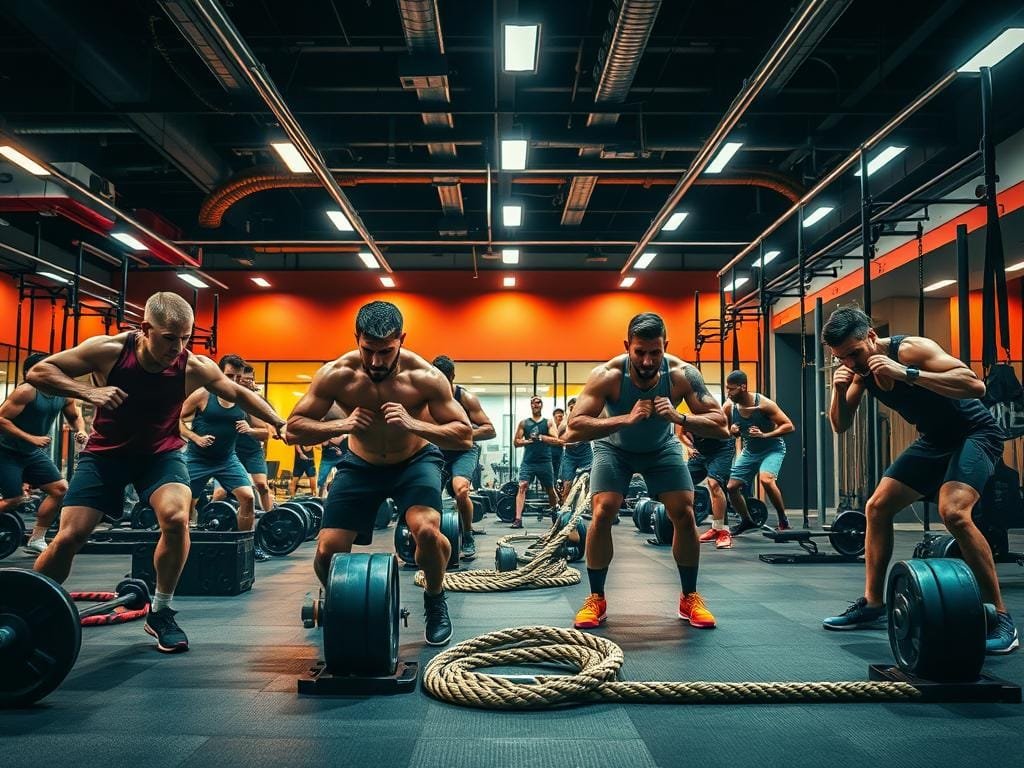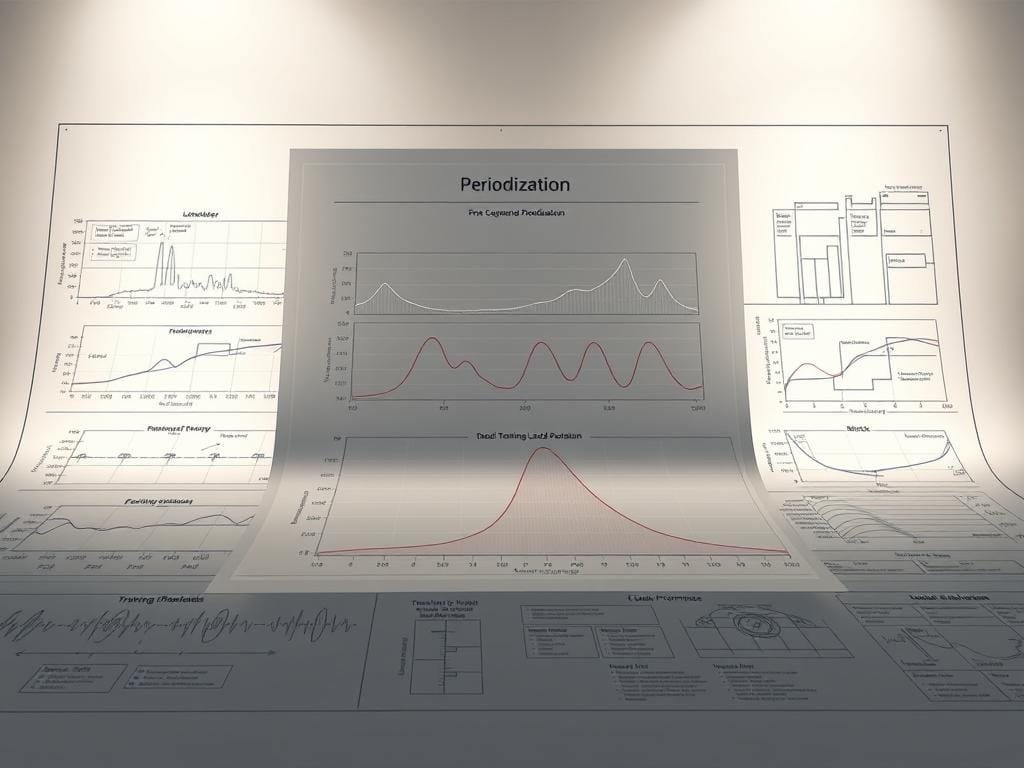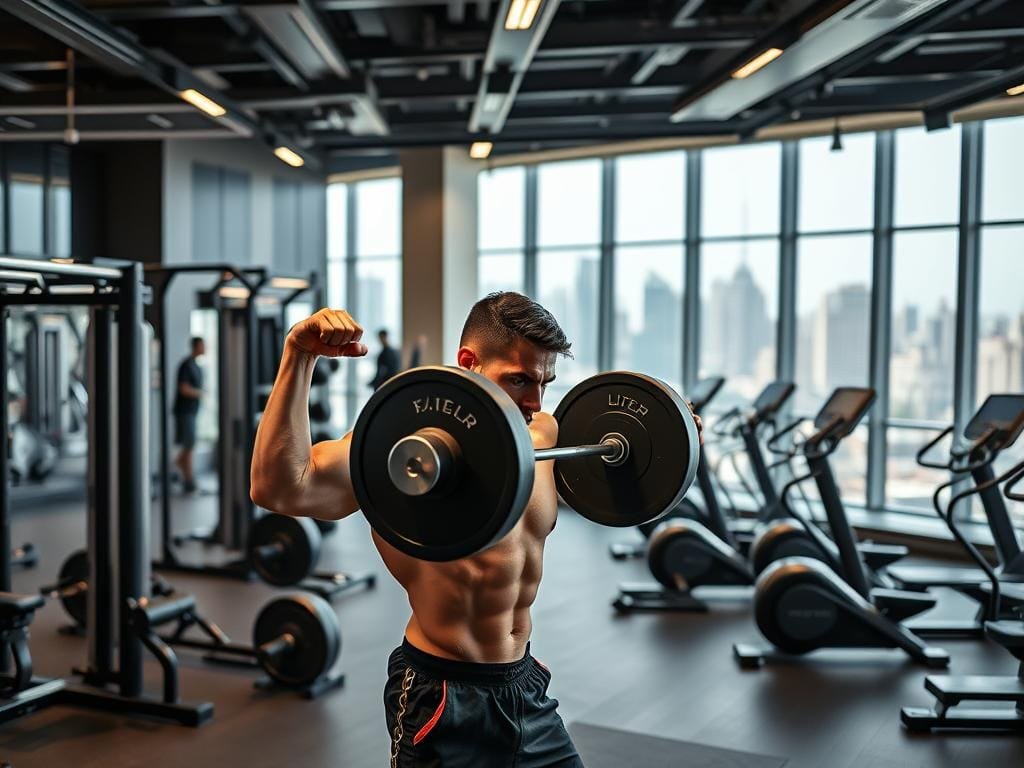Did you know a good athletic training plan can up your game by 20%? It doesn’t matter if you hit the gym every weekend or go all in. Taking care of your body is key to reaching peak performance.
To help you unleash your inner athlete, experts have come up with top-notch training methodologies. These advanced techniques aim to make your workouts better, increase your stamina, and lift your sports performance to new heights.
Table of Contents
Key Takeaways
- Proper athletic training can significantly improve performance.
- A well-structured program is essential for achieving peak performance.
- Cutting-edge methodologies can enhance endurance and boost overall sports performance.
- Elite coaches and sports scientists play a key role in creating effective training techniques.
- Optimizing workouts is key to peak performance.
The Science Behind Peak Athletic Performance
The quest for top athletic performance is based on how our bodies adapt to training. It’s key to know how our bodies react to training to excel in sports.
How Your Body Responds to Progressive Training Stimuli
Progressive training makes your body adapt to higher demands. This leads to changes that boost your athletic development. For example, as you work out harder, your muscles grow, and your heart gets better at delivering oxygen and nutrients.
Here’s a table showing how your body changes with progressive training:
| Physiological Parameter | Initial Response | Adaptation with Progressive Training |
|---|---|---|
| Muscle Fiber Size | Initial hypertrophy | Increased size and strength |
| Cardiovascular Efficiency | Improved heart rate variability | Enhanced oxygen delivery and utilization |
| Mitochondrial Density | Initial increase | Significant improvement in endurance capacity |
Key Performance Indicators from Sports Science Research
Sports science research has found important performance indicators. These include VO2 max, lactate threshold, and muscle power output. By tracking these, athletes and coaches can fine-tune training for better performance.
A study on elite athletes showed that better VO2 max means better endurance. Learn how to boost your metabolism and burn fat for better athletic performance on our blog.
By using sports science insights, you can improve your training for peak athletic performance.
Assessing Your Current Athletic Capabilities
To get better at sports, you need to know your strengths and weaknesses. This helps you make a training plan that really works for you.
Comprehensive Performance Testing Protocols
Testing your athletic skills is key. It checks how fast, strong, agile, and enduring you are.
Some tests you might see include:
- Maximal Oxygen Uptake (VO2 Max) Testing: Shows how well you handle long, steady effort.
- Wingate Anaerobic Test: Tests your quick, explosive power.
- Pro Agility Shuttle: Sees how fast you can change direction.
- Vertical Jump Test: Measures your ability to jump high and fast.

Establishing Your Athletic Baseline
Knowing where you start is important. It lets you see how far you’ve come and adjust your training.
Here’s what a baseline might look like:
| Test | Initial Score | Current Score | Improvement |
|---|---|---|---|
| VO2 Max | 45 ml/kg/min | 50 ml/kg/min | +5 ml/kg/min |
| Vertical Jump | 25 inches | 28 inches | +3 inches |
| Pro Agility Shuttle | 5.2 seconds | 4.9 seconds | -0.3 seconds |
By testing yourself often and tracking your progress, you can make your training even better.
Advanced Training Techniques for Different Athletic Goals
Athletes aiming to boost their performance need advanced training techniques that match their goals. Whether you want to up your power, sharpen your sport skills, or move better, there’s a method for you.

Power Development Methodologies
For athletes needing quick force, like sprinters or jumpers, power is key. Rotational exercises, found at this link, are great. They mirror sports movements and boost power.
Some top power-building methods include:
- Olympic lifts and their variations
- Resistance band training
- Plyometric exercises
Sport-Specific Skill Enhancement
Improving sport-specific skills means training that matches your sport’s demands. Drills that up your agility, speed, and quickness are key. For instance, soccer players can use shuttle runs and cone drills to get faster and more agile.
Here’s how to boost your sport skills:
- Drills that mimic game situations
- High-intensity interval training (HIIT)
- Video analysis to improve technique
Functional Movement Progression
Functional movement progression helps you do daily and athletic actions better. It’s about getting stronger, more flexible, and mobile. Squats, deadlifts, and lunges are great for building this strength.
To improve your functional movement, try:
- Progressive overload to challenge your muscles
- Mobility exercises to improve range of motion
- Core strengthening to enhance stability
Periodization: Engineering Your Performance Peaks
Periodization is a key concept in athletic training. It helps athletes reach their peak performance at specific times. It’s a systematic way to plan and organize training for optimal performance.
By understanding and applying periodization strategies, you can tailor your training. This meets the demands of your sport and helps you achieve your competitive goals.
Linear vs. Non-linear Periodization Models
There are two main types of periodization models: linear and non-linear. Linear periodization gradually increases intensity and decreases volume over time. It’s often used for beginners or athletes peaking for a specific competition.
Non-linear periodization varies intensity and volume more frequently, like weekly or daily. This model is great for athletes needing adaptability and variation, such as those in team sports.
| Periodization Model | Description | Benefits |
|---|---|---|
| Linear | Gradual increase in intensity, decrease in volume | Ideal for beginners, peaking for specific competitions |
| Non-linear | Frequent variation in intensity and volume | Beneficial for team sports, high adaptability required |
Block Periodization for Specialized Athletes
Block periodization divides training into blocks focused on specific areas, like strength or speed. For more information, check out periodization strategies for coaches.
This method helps athletes focus on specific performance aspects. It’s great for advanced athletes needing high specialization.

Competition-Phase Training Adjustments
As athletes near competition, their training must adjust to peak performance. This means reducing volume and possibly increasing intensity. The goal is to be fully recovered and ready to perform at the highest level.
By using these periodization strategies, athletes can optimize their training. This ensures peak performance when it matters most.
High-Intensity Training Protocols for Elite Performance
High-intensity training is key for athletes aiming for top performance. It involves short, intense workouts followed by brief rest or low-intensity activities.

HIIT Variations for Different Sports
High-Intensity Interval Training (HIIT) is tailored for each sport. It’s not a one-size-fits-all approach. For example:
- Sprinters focus on short, all-out efforts with longer rest times.
- Distance runners use HIIT to boost their anaerobic threshold with intervals at race pace.
- Team sport athletes benefit from HIIT that matches their sport’s intensity and duration.
Threshold Training and Lactate Management
Threshold training is vital for high-intensity training. It aims to raise an athlete’s lactate threshold. This is when lactic acid starts to build up, causing fatigue. Good lactate management is key for elite performance, as it lets athletes work at high intensity longer.
Effective strategies include:
- Progressive Overload: Gradually increase workout intensity to push the athlete’s threshold.
- Interval Training: Use specific intervals to boost lactate clearance and tolerance.
- Active Recovery: Add light jogging or cycling to help remove lactate between intense efforts.
Cutting-Edge Strength Development Strategies
To reach the top in sports, using the latest strength training methods is key. Building strength is vital for better performance and faster recovery.
Advanced Techniques for Enhanced Strength
There are advanced ways to boost strength. Velocity-based training, eccentric overload, and neuromuscular training are some. Each has its own benefits for athletes looking to get better.
Velocity-Based Training Implementation
Velocity-based training tracks how fast you do exercises to improve strength. It helps you focus on the speed of your movements. This makes your training more effective and reduces the chance of getting too tired.
- Use velocity-based training to adjust loads and volumes based on real-time performance data.
- Implement velocity thresholds to ensure you’re training within optimal ranges for strength development.
Eccentric Overload and Accommodating Resistance
Eccentric overload training focuses on the lowering part of exercises to build strength and muscle. Accommodating resistance, like bands or chains, changes the load as you move. This makes your muscles work harder for strength gains.
- Integrate eccentric overload into your strength training by slowing down the eccentric phase of exercises.
- Utilize accommodating resistance to vary the load and challenge your muscles more effectively.
Neuromuscular Training for Power Output
Neuromuscular training improves how your nervous system and muscles work together. This leads to better power. It’s essential for athletes who need to move quickly and powerfully.
Key aspects of neuromuscular training include:
- Plyometric exercises to enhance explosive power.
- Resistance training with an emphasis on rapid concentric phases.
Adding these advanced strength training methods to your routine can greatly improve your sports performance. Whether you’re a pro or just starting, using the latest strength training techniques is vital for top performance.
Speed and Agility: Advanced Movement Training
Boost your athletic skills with advanced speed and agility training. As an athlete, you know how vital speed and agility are. They help you beat opponents and shine in your sport.
Reactive Agility Drills for Game Situations
Reactive agility drills mimic the unpredictable sports environment. They boost your quick response to changing situations. These drills sharpen your reaction time, decision-making, and agility.
- Use visual cues to signal direction changes or actions.
- Incorporate reaction training with resistance bands or weights.
- Practice under fatigue to simulate the end of a game or intense competition.
Adding reactive agility drills to your training makes you ready for competitive sports’ dynamic settings.
Acceleration Mechanics and Sprint Technique
Mastering acceleration mechanics and sprint technique is key to reaching top speed. Focus on:
- Posture and alignment to reduce air resistance and improve stride efficiency.
- Explosive drive phase to generate maximum power.
- Transition to top speed while maintaining technique.
Enhancing your sprint technique means grasping sprinting biomechanics and practicing with precision.
Multi-directional Speed Development
Multi-directional speed is vital for sports needing quick direction changes. Training should include:
- Shuttle runs to improve acceleration and deceleration.
- Cone drills for agility and quick changes of direction.
- Lateral movements to enhance side-to-side speed.
By boosting your multi-directional speed, you’ll outperform in sports needing fast direction changes.
In conclusion, advanced speed and agility training covers reactive agility drills, sprint technique, and multi-directional speed. Focusing on these areas greatly improves your athletic performance.
Mental Performance Training for Athletes
As you aim for the top in sports, remember that mental prep is as key as physical training. Mental performance training uses various methods to boost an athlete’s mental strength, focus, and competitive edge.
Psychological Skills for Competition Readiness
Building psychological skills is vital for athletes to shine in competitions. Skills like self-talk, setting goals, and managing emotions can greatly affect an athlete’s ability to stay focused and calm under stress. Effective self-talk, for example, can increase confidence and improve performance by using positive affirmations.
Setting goals is also a key skill for athletes to stay motivated and on track. By setting clear, reachable goals, athletes can handle competition pressure better and stay focused on their goals.
Visualization and Mental Rehearsal Techniques
Visualization and mental rehearsal are strong tools for athletes to prepare for games. By mentally practicing their performances, athletes can sharpen their skills, prepare for different situations, and boost their confidence. Visualization involves creating clear mental pictures of successful performances, which can make athletes mentally tougher and more resilient.
Mental rehearsal also helps by letting athletes practice various game scenarios. This improves their ability to handle pressure well.
Stress Management for Optimal Performance
Managing stress well is essential for athletes to perform at their best. Methods like deep breathing, progressive muscle relaxation, and mindfulness meditation can help athletes control their stress and anxiety. By learning to handle their body’s stress response, athletes can perform more consistently and at a higher level.
Stress management also helps in recovery, allowing athletes to recover faster from intense training and games.
Recovery Science: Optimizing the Adaptation Process
Recovery is key in athletic training. It lets your body adjust to the challenges it faces. Good recovery strategies help athletes perform better and reach their goals.
Recovery science offers many techniques to help your body heal and adapt. By using these methods, you can boost your athletic skills.
Advanced Recovery Modalities and Technologies
There are advanced recovery methods and tools to speed up recovery. Some top ones are:
- Contrast water therapy
- Compression garments and pneumatic compression devices
- Electrostimulation and electrical muscle stimulation (EMS)
- Normobaric hypoxia training
These methods can be used alone or together to improve recovery. For instance, contrast water therapy uses hot and cold water to boost blood flow and lessen muscle swelling.
Sleep Optimization for Elite Athletes
Sleep is vital for recovery, helping your body fix and adjust to training. Elite athletes need good sleep to perform at their best.
Here are ways to improve sleep:
- Keep a regular sleep schedule
- Make your sleep area comfortable
- Stay away from screens before bed
- Try relaxation techniques like meditation or deep breathing
| Sleep Optimization Strategy | Description | Benefits |
|---|---|---|
| Consistent Sleep Schedule | Go to bed and wake up at the same time daily | Regulates body’s internal clock |
| Sleep-Conducive Environment | Create a dark, quiet sleep environment | Improves sleep quality |
| Relaxation Techniques | Practice meditation or deep breathing before bed | Reduces stress and promotes relaxation |
Nutritional Strategies for Enhanced Recovery
Nutrition is essential for recovery, giving your body the nutrients it needs to heal and adapt. Good nutrition for recovery includes:
- Eat a balanced diet with protein, complex carbs, and healthy fats
- Use supplements like protein shakes or creatine
- Drink plenty of water to stay hydrated
- Match your nutrition with your training schedule
For more tips on training and recovery, check out Arthur Care’s insights on MSK care.
Working With Performance Specialists and Coaches
Working with performance specialists and coaches can really help athletes improve. They offer valuable knowledge and help athletes fine-tune their skills. This can help athletes reach their goals.
Finding the Right Expertise for Your Goals
To find the right coach, think about what you want to achieve in sports. Look for someone with experience in your sport. Make sure they have good credentials and success stories.
It’s also important to find someone you can work well with. Consider these factors:
- Do they have experience with athletes like you?
- Do they know the latest training methods and technologies?
- Can they give you personalized advice and support?
Integrating Coach Feedback into Training
Once you’ve found a good coach, it’s key to use their advice in your training. Be open to their suggestions and track your progress.
Here are some tips to use coach feedback well:
- Keep a training log to see how you’re doing and what you need to work on.
- Change your training plan based on what your coach says.
- Talk openly with your coach about your goals, problems, and worries.
Technology-Enhanced Coaching Methods
Technology has changed how coaches and athletes work together. Tools like video analysis, wearable devices, and data analytics give insights into performance. This helps find areas to get better.
Here are some tech-enhanced coaching methods:
- Video analysis to improve technique and biomechanics.
- Wearable devices to track heart rate and GPS data.
- Data analytics platforms to monitor progress and adjust training plans.
By using these technologies and working with coaches, athletes can get ahead. This helps them achieve their goals more effectively.
Conclusion: Maintaining Your Athletic Evolution
As you’ve progressed through the advanced training techniques outlined, it’s clear that maintaining athletic progress requires ongoing effort and commitment. Your athletic evolution is a continuous process. It’s driven by the principles of progressive overload, periodization, and recovery.
To sustain long-term athletic development, it’s essential to remain adaptable. Incorporate new methodologies and technologies as they emerge. This way, you’ll be able to maintain peak performance and continue making progress toward your goals.
Your journey doesn’t end here; it’s a continuous cycle of improvement. Focus on maintaining progress, and you’ll be well on your way to achieving sustained athletic success. You’ll realize your full athletic and personal growth.

